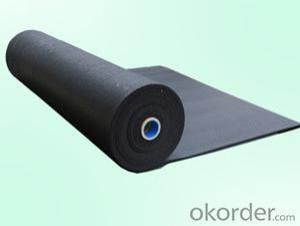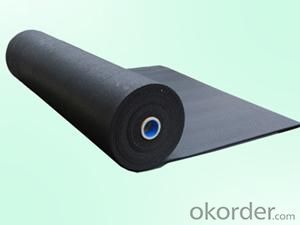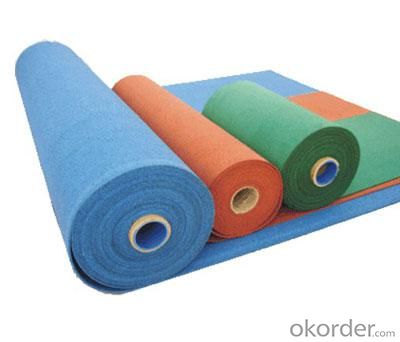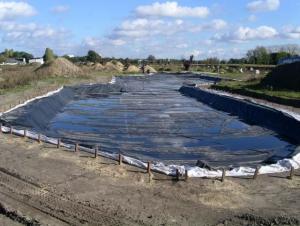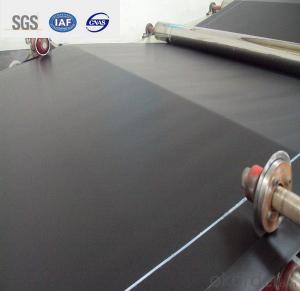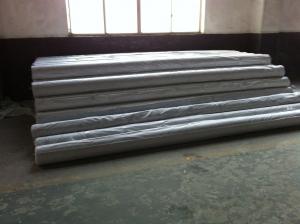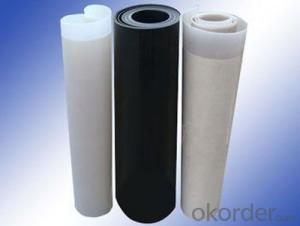EPDM waterproof membranes
- Loading Port:
- China Main Port
- Payment Terms:
- TT OR LC
- Min Order Qty:
- -
- Supply Capability:
- -
OKorder Service Pledge
OKorder Financial Service
You Might Also Like
EPDM Rubber Waterproofing membranes
Products Description
EPDM Rubber Waterproofing membranes is a synthetic rubber, synthetic tire blends as the base
material, adding reinforcing agents, softeners, antioxidants, curing agents processing aids to promote
mixing by kneading, mixing, extrusion, rolling and curing, shaping and other processes can be
processed into sheet curling volume of new high elastic waterproof material.
Products Specification
Category: Single, Compound and Reinforced
Thickness: 1.2mm 1.5mm 2.0mm
Width: 1-2m
Length: 10-50m
Physical Properties
EPDM Rubber Waterproofing membranes physical propertites
The item name | Applicable test items | ||||
(N/cm) Tension Strength (MPa) | Normal temperature≥ | 7.5 | GB6.3.2 | ||
60℃≥ | 2.3 | ||||
Elongation at break% | Normal temperature≥ | 450 | |||
-20℃ | 200 | ||||
Tear strength N | ≥ | 25 | GB6.3.3 | ||
(0.3Mpa.30 min)Water tightness | No seeage | GB6.3.4 | |||
Flexibility at low temperature ≤ | -40 | GB6.3.5 | |||
Heat expansion (mm) | Extended ≤ | 2 | GB6.3.6 | ||
Contraction ≤ | 4 | ||||
(80℃×168h) Hot air ageing | Fracture tensile strength retention %≥ | 80 | GB6.3.7 | ||
Keep rate tore elongation %≥ | 70 | ||||
Alkaline [10%Ca(OH)2 Normal temperature×168h]
| Fracture tensile strength retention %≥ | 80 | GB6.3.8 | ||
Keep rate tore elongation %≥ | 80 | ||||
(40℃×168h),200×10-8 Ozone aging | — | GB6.3.9 | |||
Artificial climate ageing | Fracture tensile strength retention %≥ | 80 | GB6.3.10 | ||
Elongation at failure rate | 70 | ||||
Bond peel strength | Standard test condition | 1.5 | GB6.3.11 | ||
Flood retention(Normal temperature×168h) %≥ | 70 | ||||
Application Range
Mainly used in all types of Industrial and civil buildings roofing, office buildings, supermarkets, steel roofing, basements,
tunnels, bridges and other impermeable, waterproof construction.

- Q: Can a waterproofing membrane be used in temporary or temporary structures?
- Yes, a waterproofing membrane can be used in temporary or temporary structures. It provides an effective barrier against moisture, protecting the structure from potential water damage during its temporary lifespan.
- Q: Can a waterproofing membrane be applied to both interior and exterior surfaces?
- Yes, a waterproofing membrane can be applied to both interior and exterior surfaces.
- Q: Can a waterproofing membrane be used for exterior foundation walls?
- Exterior foundation walls can indeed benefit from the application of a waterproofing membrane. These membranes serve as a defense against water infiltration and are widely utilized in construction to safeguard below-grade structures, like foundation walls, from moisture intrusion. Crafted from robust materials such as rubber, asphalt, or polymer-based compounds that resist water penetration, these membranes form an impermeable shield. Placing a waterproofing membrane on the outside of foundation walls effectively establishes a barrier that thwarts water from seeping into the foundation. This preventive measure aids in averting problems such as water damage, mold growth, and structural decay. Moreover, the utilization of waterproofing membranes also diminishes the risk of cracks and leaks in the foundation, thereby improving the overall resilience and longevity of the structure.
- Q: Are waterproofing membranes resistant to seawater?
- Yes, waterproofing membranes are resistant to seawater. These membranes are designed to provide a barrier against water and are specifically engineered to withstand the harsh conditions of seawater. They are made from materials that are highly resistant to saltwater corrosion and are tested to ensure their effectiveness in preventing water penetration, including the corrosive effects of seawater. This makes waterproofing membranes an ideal choice for applications where seawater exposure is a concern, such as in marine structures, coastal buildings, and swimming pools.
- Q: Can a waterproofing membrane be used for a roof?
- Yes, a waterproofing membrane can be used for a roof. Waterproofing membranes are specifically designed to provide a barrier against water penetration, making them an ideal choice for protecting roofs from leaks and water damage. They are durable, flexible, and can be applied to various types of roofs, including flat and sloped surfaces.
- Q: Can a waterproofing membrane be used in coastal areas?
- Yes, a waterproofing membrane can be used in coastal areas. These membranes are specifically designed to withstand harsh weather conditions, including exposure to saltwater, high humidity, and extreme temperatures. They provide an effective barrier against water penetration and can protect structures from the damaging effects of coastal environments.
- Q: Can a waterproofing membrane be used for a parking lot?
- Yes, a waterproofing membrane can be used for a parking lot. Waterproofing membranes are commonly used in parking lots to protect the underlying structure from water damage and extend its lifespan. They provide a barrier against water penetration and can help prevent cracks, deterioration, and corrosion caused by moisture. Additionally, a waterproofing membrane can also help to minimize the formation of potholes and other surface damage.
- Q: Can a waterproofing membrane be used for residential swimming pools?
- Yes, a waterproofing membrane can be used for residential swimming pools. Waterproofing membranes are commonly used in construction to prevent water penetration and can be applied to various surfaces such as concrete, tile, and metal. They create a barrier that prevents water from seeping into the pool structure, which helps to maintain the integrity of the pool and prevent leaks. Additionally, waterproofing membranes can also protect against other forms of damage such as corrosion and deterioration caused by chemicals or harsh weather conditions. It is important to select a high-quality waterproofing membrane that is specifically designed for swimming pool applications to ensure long-lasting protection and durability.
- Q: Can a waterproofing membrane be exposed to sunlight?
- Certainly, sunlight poses no problem for a waterproofing membrane. In reality, numerous waterproofing membranes are engineered to endure extended exposure to sunlight without any degradation or loss of efficacy. Nevertheless, it is vital to acknowledge that not all waterproofing membranes possess equal resistance to UV rays, hence it is crucial to select a membrane explicitly designed for outdoor applications and capable of withstanding sunlight exposure. Furthermore, it is always advisable to adhere to the manufacturer's instructions and guidelines pertaining to the particular waterproofing membrane being utilized, in order to guarantee its longevity and optimal performance.
- Q: Can a waterproofing membrane be used for a foundation?
- Yes, a waterproofing membrane can be used for a foundation. Waterproofing membranes are commonly used to prevent water infiltration and protect foundations from moisture damage. They create a barrier against water and can help keep basements and crawl spaces dry.
Send your message to us
EPDM waterproof membranes
- Loading Port:
- China Main Port
- Payment Terms:
- TT OR LC
- Min Order Qty:
- -
- Supply Capability:
- -
OKorder Service Pledge
OKorder Financial Service
Similar products
Hot products
Hot Searches
Related keywords
